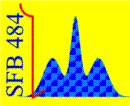
Second International Workshop 2004
Ordering Phenomena in Transition Metal Oxides
September 26 - 29, 2004, Wildbad Kreuth
|
Welcome Pictures taken at the Workshop Invited Speakers Program Poster Session Social Program Organization Technical Information Travel Information Weather SFB 484 Institute of Physics |
|
Invited Talk
|
|
| M. Grüninger (Köln), K. P. Schmidt, and G. S. Uhrig | |
|
Coupled spin ladders, stripes and the neutron resonance mode
|
|
|
The dynamic spin susceptibility measured in inelastic neutron
scattering experiments is one of the most widely discussed issues in
the field of high-temperature superconductivity. Two features have
been in the focus of interest: the resonance peak appearing in the
superconducting phase and stripe order which manifests itself in
superstructure satellites. For many years, these two features were
regarded as separate issues, each of them apparent in only one of
the two families of cuprates on which most neutron studies have
focused: LSCO and YBCO. However, recent experimental results show
that the resonance peak in YBCO is accompanied at lower energies by
incommensurate reflections, and that stripe order appears also in
YBCO. Very recently, Tranquada et al. [1] observed a resonance peak
also in stripe-ordered
La15/8Ba1/8CuO4 (for
T>Tc).
The resonance peak is a prominent feature of many different
theoretical scenarios. Its interpretation ranges from a
particle-hole bound state to a particle-particle bound state in
SO(5) theory. The magnetic excitations of the stripe-ordered phase,
on the other hand, have not been analyzed in great detail and are
often discussed as simple 'vertical rods' in momentum space.
Based on a two-dimensional model of coupled two-leg ladders, we
calculate the dispersion and the magnetic structure factor for the
case of static stripe order [2]. We derive a unified description of
the low-energy superstructure modes, of the resonance peak and of
the high-energy excitations observed by Tranquada et al. [1]. The
superstructure modes arise from a ferromagnetic coupling between
neighboring ladders, whereas the resonance peak in the
stripe-ordered phase corresponds to a saddle point of the triplon
dispersion. The central result is that we arrive at a quantitative
agreement with the neutron data of Ref. [1] for realistic values of
the exchange parameters. In particular a cyclic exchange of
Jcyc/J ≈ 0.2-0.25 is required to match the
resonance peak position and the spectral intensity. It is very
intriguing that a spin-only model of coupled ladders generically
shows the effects observed in the superconducting phase: a resonance
mode and excitation branches dispersing to both higher and lower
energies.
[1] J. M. Tranquada et al., cond-mat/0401621, to be published in Nature. [2] G. S. Uhrig, K. P. Schmidt and M. Grüninger, cond-mat/0402659. |
|
|
previous / next - Invited Speakers - Program |
|
| [ 21-Apr-17 ] | [ http://www.physik.uni-augsburg.de/sfb484/Kreuth2004/abstracts/grueninger.shtml ] |